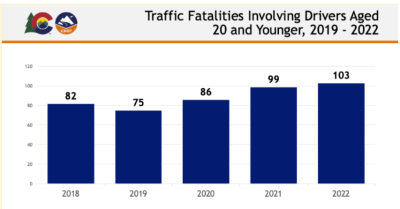
Graduates begin entering for the 2023 BVHS Commencement. Photo by Carly Winchell.
“The pressure to drink is high; make a plan for a sober ride home.”
Graduation is a major milestone in a young person’s life and deserves to be celebrated, but some teenagers will potentially throw away their future or their lives by getting behind the wheel impaired after celebrating. While young teens (ages 0 to 17) are one of the smallest age groups, Colorado State Patrol (CSP) troopers arrested forty-one for impaired driving last year.

Graph showing traffic fatality rates for those 20 and younger from 2019 to 2022. Courtesy of codot.gov
CSP notes that motor vehicle crashes are still the leading cause of death for U.S. teens and reminds parents that they can play a pivotal role in reducing risky behavior with their young drivers.
“With a diploma in hand, some parents may think it is pointless to talk to their child about being safe, including impaired driving,” said CSP Chief Colonel Matthew C. Packard. “But as your child and their friends celebrate and enjoy their last summer before their next big step, parents can and should talk about the impacts of alcohol and drugs on a driver’s judgment, reaction time, and coordination.”
Last year one out of every three traffic deaths in Colorado involved impaired driving. According to CDOT, over 16,000 teenagers between the ages of 15 and 19 were involved in crashes, and 61 teen drivers died in Colorado as of October 16, 2023.
The Centers for Disease Control and Prevention have noted that teens are more likely to be killed in an alcohol-related crash than any other demographic. Some 19 percent of 15 to 18-year-old drivers involved in fatal crashes in 2021 had been drinking.
The problem isn’t limited to alcohol. A 2023 CDOT survey found that 18 to 24 year-olds consume cannabis more than twice as often as the average driver and are more than twice as likely to report driving high.
“Gen Z was also more than twice as likely to report driving high in the last 30 days. One out of five (20 percent) of 18 to 24 year-old drivers said they had driven within two hours of using cannabis at least once within the last month compared to 7 percent of older Colorado drivers,” stated CDOT.
The 2020 DUI (Driving Under the Influence) Colorado Division of Criminal Justice case filing data shows drivers aged 16 to 23 had the highest positivity rate (62.5 percent) when screened for THC and other cannabinoids. Drivers aged 24 to 38 tested positive 44 percent of the time. Traffic safety data over time shows the youngest groups are always the most at-risk.
Parents play a critical role in reducing these statistics through positive modeling and open discussion.
Parents should reflect upon their own behavior and try to model what they would want their child to do if impaired. Parents should ask themselves how they behave in front of young drivers. Do they drink a few beers or consume marijuana or other drugs and then drive? Do they have a designated driver or other safe transportation home, like a rideshare readily available if they are impaired?
Parents can also make an impact by openly discussing the consequences of driving impaired and the options available to anyone intoxicated. Relating the conversation to what’s happening at school (Has someone from school been pulled over while under the influence or alcohol or drugs?) or telling a story from past life experiences, including its consequences, can begin the dialogue between parents and their young drivers.
“There is no age limit to talking about alcohol and drugs with your loved ones,” stated Colonel Packard. “Let your teen know they can text or call you for a ride home in an unsafe situation. You may be disappointed that your child or their friends chose to drink or get high, but this is nothing compared to what you’d feel if they never made it home.”
Other concerns include fentanyl, which is now involved in at least 75 percent of adolescent overdose deaths according to a study published in The New England Journal of Medicine in early 2024.
An author of the study, Joseph Friedman, identified Colorado as the state with the second-highest youth overdose rate in the country, just behind Arizona. Colorado had 125 youth overdose deaths in a three-year time period covered by the study, which is 2.31 times the national average. Native American and Hispanic teens are disproportionately affected.
CDOT’s Meet the Effects campaign seeks to raise awareness of the dangers of driving high. “THC is proven to slow reaction time, reduce focus, and temporarily weaken problem-solving skills. Consuming THC affects you differently than alcohol, but it impairs driving ability all the same,” reports CDOT.
CDOT’s Shift Into Safe videos are available online in English and in Spanish.
CSP Troopers continue to take a low-tolerance approach to the top fatal crash factors, including lane violations, impaired driving, and speeding while launching a yearlong campaign called “Drive Safe.” This campaign reminds people to reflect on everything they love and value and plan a sober ride when planning to celebrate any occasion.





Recent Comments